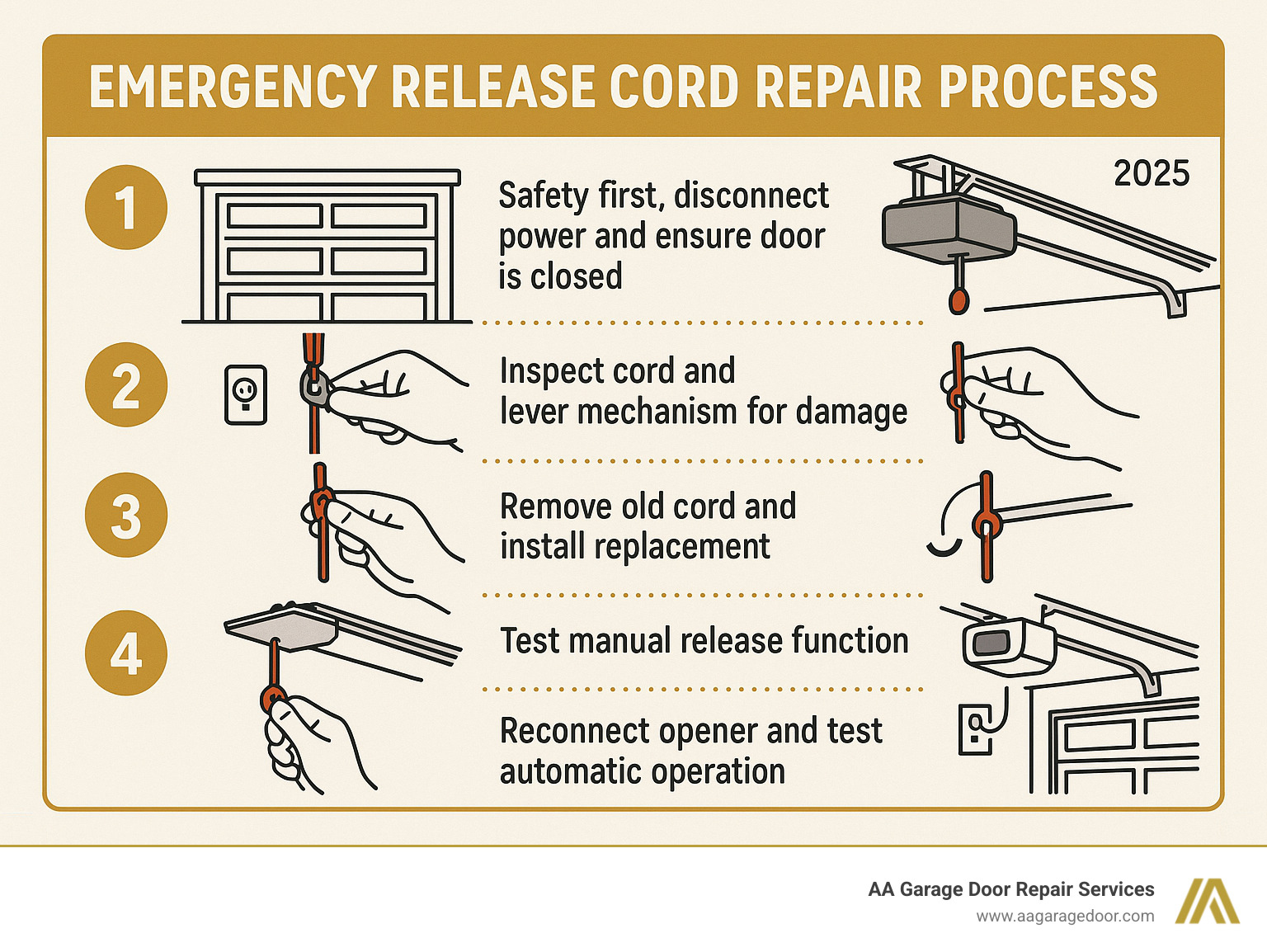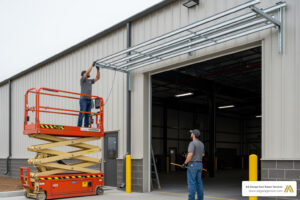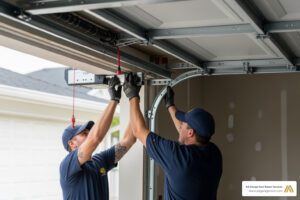When Your Garage Door Emergency Cord Fails
When your garage door release cord broke, it can be a frustrating experience, especially during a power outage. This cord is a critical safety feature that allows you to operate your door manually. Fortunately, fixing it is often a straightforward DIY task.
Here’s a quick overview of what to do:
Immediate Steps:
- Safety First: Ensure the garage door is fully closed and disconnect the opener from power.
- Inspect: Check the cord and the release lever it connects to for damage.
- Replace: If the cord is just frayed or snapped, replace it.
- Test: After replacing, test the manual release before restoring power.
Call a Pro If:
- The trolley or carriage assembly is damaged.
- You see broken or loose springs.
- You are not comfortable performing the repair.
Don’t let a broken cord leave you stranded. While many repairs are manageable, knowing when to call for reliable garage door repair services ensures your safety and prevents further damage. This guide will walk you through the diagnosis and repair process, helping you decide the best course of action.

Understanding the Emergency Release Mechanism
The red cord hanging from your garage door opener is a critical safety feature. When your garage door release cord broke, understanding its function is key to a safe repair. The cord allows you to switch the opener from automatic to manual mode, giving you control during a power outage or opener malfunction.
What is the Emergency Release Cord?
The emergency release cord is your manual override. During a power failure or opener issue, this red-handled cord lets you disconnect the door from the opener’s motor. It typically hangs from the opener’s track, within easy reach. A firm pull disengages the door, allowing you to lift it by hand. It’s designed for quick, tool-free emergency access, putting you back in control when the automatic system fails.
How the Trolley and Carriage Work Together
Two key components make this system work: the carriage and the trolley assembly.
- The Carriage: This part is moved by the opener’s motor along the rail and is responsible for pulling the door open and pushing it closed.
- The Trolley Assembly: This is attached to the garage door itself and connects to the carriage. It features a spring-loaded lever.
During normal operation, the trolley is locked into the carriage, allowing the motor to move the door. When you pull the emergency release cord, it activates the lever on the trolley, disconnecting it from the carriage. This breaks the link to the motor, allowing for manual operation.
To re-engage the system, you typically reset the lever and run the opener. The carriage will travel along the rail and automatically click back into the trolley, restoring automatic function. A broken cord removes this vital override capability, making a quick repair essential for safety and convenience.
What to Do When Your Garage Door Release Cord Broke
When your garage door release cord broke, it’s an inconvenience, but often a manageable one. Before you start, safety is paramount when working on a heavy garage door system.
Safety First: Critical Precautions Before You Begin
Garage doors are heavy and their springs are under extreme tension. Rushing into a repair can be dangerous. Follow these essential safety steps:
- Disconnect Power: Always unplug the garage door opener from the electrical outlet before beginning any work.
- Close the Door: Ensure the door is in the fully closed position. If it’s stuck open, carefully lower it and secure it with C-clamps on the tracks below the bottom rollers to prevent it from falling.
- Do Not Touch the Springs: Torsion or extension springs are under high tension and require special tools and expertise. Leave them to the professionals.
- Wear Protective Gear: Use gloves and safety glasses to protect yourself from pinch points and debris.
For more details, review our Garage Door Safety Tips for Homeowners.
Diagnosing Why Your Garage Door Release Cord Broke
Understanding the cause helps determine the right fix. Common reasons include:
- Normal Wear and Tear: Over time, the cord can fray, thin, and eventually snap from use and exposure to temperature changes.
- Physical Damage: The cord may have been snagged or pulled by a vehicle, ladder, or other stored items.
- Stuck Release Lever: The cord itself might be fine, but the metal lever it attaches to could be stuck due to rust, debris, or damage.
- Misalignment: If the trolley or other components are misaligned, it can put extra strain on the cord, leading to premature failure.
Step-by-Step: How to Replace a Garage Door Release Cord that Broke
If the cord is the only issue, this is a simple DIY fix.
Tools Needed:
- Replacement garage door release cord
- Pliers
- Stepladder
Instructions:
- Remove the Old Cord: Use pliers to remove any remaining pieces of the broken cord from the release lever on the trolley.
- Thread the New Cord: Feed the new cord through the hole or loop on the release lever.
- Tie a Secure Knot: Use a strong knot, like a figure-eight or double overhand knot, to secure the cord to the lever. Tug it to ensure it’s tight.
- Attach the Handle: Thread the other end of the cord through the red handle and tie another secure knot. Adjust the length so the handle is about six feet from the floor.
- Test the Mechanism: Gently pull the new cord to ensure the lever moves freely. Do not reconnect power yet. This test is purely mechanical.
Manually Operating and Resetting Your Garage Door
After you’ve addressed the issue where the garage door release cord broke, you’ll need to operate the door manually and then re-engage the opener. This process is straightforward if you follow the steps carefully.
How to Manually Open and Close the Door
With the opener disengaged, your door is in manual mode.
- Pull the Cord: Give the red release cord a firm pull downwards. You should hear a click as the trolley disengages from the carriage.
- Lift the Door: Grasp the bottom of the door with both hands and lift slowly and evenly. A well-balanced door should be manageable. If it feels extremely heavy or sticks, stop immediately as this indicates a more serious problem with the springs or tracks. Get help if needed.
- Secure the Door if Open: If you need to leave the door open, secure it by placing C-clamps or locking pliers on the vertical tracks just above the bottom rollers on both sides.
- Close the Door: To close, carefully guide the door down until it is fully shut.
Re-engaging the Opener for Automatic Use
Once you’re ready to restore automatic operation, follow these steps to reconnect the opener.
- Ensure the Door is Closed: This is a critical safety step. Never attempt to re-engage the opener with the door open, as it could crash down.
- Reset the Release Lever: Pull the emergency release cord down and toward the garage door (away from the motor). This should set the lever into the “ready to connect” position.
- Reconnect the Trolley: For most modern openers, you can simply plug the unit back in and press your remote or wall button. The opener’s carriage will travel along the rail and automatically lock back into the trolley. On some models, you may need to manually lift the door until the trolley and carriage click together.
- Test Operation: Use your remote to open and close the door to ensure it’s working smoothly. For a visual guide, you can watch a demonstration of this process.
If the door jerks, makes strange noises, or fails to operate correctly, disconnect the power again and call a professional. There may be an underlying issue.
When to Call a Professional vs. DIY Repair
While replacing a broken release cord can be a simple DIY project, garage doors are complex systems. Knowing when to call an expert is key to ensuring your safety and preventing more costly damage.
Dangers of a DIY Fix and Signs of a Bigger Problem
Attempting a repair without the right knowledge can be dangerous. The biggest risk involves the high-tension springs, which can cause serious injury if mishandled. Never attempt to adjust or repair garage door springs yourself. A DIY fix can also lead to further damage to the opener, tracks, or door panels.
A broken cord can also be a symptom of a larger issue. Look for these red flags:
- The opener motor runs, but the door doesn’t move.
- The door gets stuck while opening or closing.
- The opener makes grinding, clanking, or other unusual noises.
- The plastic or metal parts of the trolley or carriage are visibly cracked or broken.
If you notice any of these signs, the problem goes beyond the cord. For more information, see our guide on 3 Garage Door Repairs Best for the Professionals.
Comparing DIY vs. Professional Repair
| Aspect | DIY Repair (Cord Replacement) | Professional Repair |
|---|---|---|
| Cost | Low (materials only) | Higher (service charges included) |
| Time | Quick for a simple fix, but can be prolonged if issues arise | Fast response and efficient repair |
| Safety | Risky without proper precautions | High, due to professional training and equipment |
| Tools | Basic household tools | Specialized tools for all repairs |
| Warranty | None | Warranty on parts and labor |
| Complexity | Best for simple cord replacement only | Handles all levels of complexity |
When to Call for Emergency Service
It’s time to call a professional when:
- Your garage door is stuck in the open position, posing a security risk.
- You hear a loud bang, which could indicate a snapped spring or cable.
- The opener motor is running, but the door remains stationary.
- You feel unsafe or unsure at any point during the repair.
- The door feels extremely heavy or binds when you try to lift it manually.
For immediate assistance, contact our Emergency Garage Door Repair team. We ensure you’re not left in a bind when your garage door release cord broke.
Preventing Future Cord and Cable Issues
To avoid dealing with a garage door release cord broke again, a little preventive maintenance can make a big difference. Regular care keeps your emergency release system reliable.
How can regular maintenance help prevent problems with the emergency release cord?
Regular maintenance is key to the longevity and proper function of your garage door’s safety features. Here are a few simple steps you can take:
- Monthly Visual Inspections: Check the cord for fraying or wear. Inspect the metal release lever for rust or damage.
- Clear Obstacles: Ensure that stored items, equipment, or even cobwebs are not interfering with the cord or trolley mechanism.
- Lubricate Moving Parts (Not the Cord): While the cord itself should never be lubricated, the metal components of the release lever, trolley, and carriage benefit from proper lubrication. This reduces strain on the cord.
- Test the System: Periodically pull the release to ensure it operates smoothly. If it feels stiff or hard to pull, investigate the cause before it leads to a break.
- Schedule Professional Maintenance: An annual tune-up by a professional can catch subtle issues you might miss. A technician will lubricate all moving parts and ensure the entire system is in optimal condition.
Consistent maintenance provides peace of mind, ensuring your emergency release will work when you need it most. For a complete checklist, explore our guide on Garage Door Maintenance.
Frequently Asked Questions about Broken Release Cords
When your garage door release cord broke, questions are natural. Here are answers to some of the most common ones we hear from homeowners.
How much does it cost to fix a broken garage door release cord?
- DIY Cost: This is a very affordable fix. A replacement cord costs under $10 at a hardware store.
- Professional Cost: A service call for a simple cord replacement typically ranges from $100 to $150. If the broken cord is a symptom of a larger issue, like a damaged trolley, the cost could be higher. A professional diagnosis can identify underlying problems.
For more detailed pricing information, see our guide on Garage Door Repair Cost.
Can I still use my garage door if the release cord is broken?
Yes, your automatic opener will likely still function if the trolley remains engaged with the carriage. However, you lose the ability to open the door manually. This is a significant safety risk during a power outage or opener failure. A dangling broken cord can also get caught in the door’s mechanism. It is critical to repair the cord as soon as possible.
Why is my emergency release cord stuck or hard to pull?
A cord that is difficult to pull is a warning sign. Do not force it. The most common causes are:
- Debris or Obstruction: Dirt, cobwebs, or small objects are jamming the release lever.
- Corrosion: Rust on the metal components of the trolley is causing them to bind.
- Lack of Lubrication: The moving parts of the release mechanism need lubrication to move freely.
- Misalignment: Bent or misaligned parts can create friction.
- Spring Problems: An issue with the main garage door springs could be putting unusual tension on the release mechanism, which is a serious problem that requires a professional.
Your Trusted Partner for Garage Door Emergencies
A broken release cord is an inconvenience, but your safety is the top priority. While a simple cord replacement can be a DIY task, complex problems or any uncertainty should be handled by a professional.
AA Garage Door Repair Services offers 24/7 support to ensure you’re never left stranded. Serving the Twin Cities community, including St. Paul, Minneapolis, and Hudson, WI, since 2001, we understand that emergencies happen at any time. Our experienced technicians are always ready to help.
We pride ourselves on transparent pricing and a satisfaction guarantee. Our team arrives with fully equipped trucks to handle most repairs in a single visit, from simple fixes to complex opener issues. We are committed to providing high-quality, reliable service to our neighbors across Minnesota and Western Wisconsin.
For fast, reliable help when your garage door release cord broke or for any other garage door issue, schedule your emergency garage door repair online or call us at (651) 702-1420. Don’t let a broken cord leave you stuck-we’re here to get you back on track quickly and safely.








